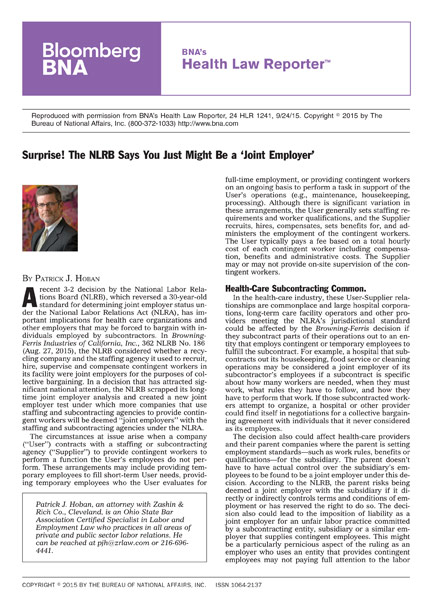
Z&R Press
Press and Media
Law360
Mocktails Seen As Key Ingredient For Holiday Party Inclusivity
November 8, 2023
Cleveland Metropolitan Bar Journal
Women in Law
April 2020
Smart Business Cleveland
2017 Smart Business Family Business Achievement Awards
September 2017
Crain's Cleveland Business
Ohio Employers Confront Marijuana Use
July 22, 2017
Sports Illustrated
Lane Johnson's Bold Move To Sue His Own Union Is Rare, But Not Unprecedented
January 11, 2017
Law360
Packers Player Drops NFL Drug Suspension Dispute
December 19, 2016
Sports Business Daily
NFL, NFLPA Appoint Das As Third Arbitrator In Michael Pennel Lawsuit
December 5, 2016
Sports Business Journal
Eagles Lineman Challenges NFL and NFLPA in NLRB Filings
December 5, 2016
Law360
Eagles Lineman Says Suspension Violates Federal Labor Law
November 29, 2016
The Business of Sports with Andrew Brandt
RTAB #30: Lane Johnson's Legal Team (Audio Interview)
November 29, 2016
BNA's Health Law Reporter
Surprise! The NLRB Says You Just Might Be a 'Joint Employer'
September 24, 2015
BNA's Health Law Reporter
NLRB Adopts New Joint Employer Standard; Ruling Could Affect Health-Care Industry
September 3, 2015
BNA's Health Law Reporter
Challenge to NLRB Election Rule Fails; Employers Urged to Prepare New Game Plan
June 11, 2015
American Bar Association Section of Labor and Employment Law
Member Spotlight: George S. Crisci
April 13, 2015
Crain's - Article and Video
Zashin & Rich embraces Cleveland roots and rock 'n' roll heritage
November 16, 2014
BNA's Health Law Reporter
Justices Reject NLRB Recess Appointments; Significant Health Care Decisions in Limbo
July 10, 2014
BNA's Health Law Reporter
The EEOC and FTC Turn Up the Heat on Employer Background Checks
April 2014
Crain’s
Zashin & Rich move marks big milestone
for E&Y Tower
November 2013
Cleveland.com
Zashin & Rich law firm leases last full floor of Ernst & Young Tower at Flats East Bank project
November 2013
CCH Employment Law Daily
NLRB NEWS - Controversy Erupts Over NLRB Recess Appointments
January 2012
Crain’s
Companies should consider coverage against employee-related claims
By Stephen Zashin | July 2004
Crain’s
ADR programs can save dollars and time
By Stephen Zashin | November 2003
COSE Update: Legal Ease
One Size Does Not Fit All
(Employment Practices Liability Insurance)
By Stephen Zashin
COSE Update: Legal Ease
Noncompete Agreements
By Michele Jakubs
COSE Update: Legal Ease
Ohio's 'Baby COBRA' Law
By Helena Oroz
BNA's Health Law Reporter™
Surprise! The NLRB Says You Just Might Be a 'Joint Employer'
September 24, 2015 | Patrick J. Hoban | Download PDF
Reproduced with permission from BNA's Health Law Reporter, 24 HLR 1241, 9/24/15.
Copyright 2015 by The Bureau of National Affairs, Inc. (800-372-1033)

A recent 3-2 decision by the National Labor Relations Board (NLRB), which reversed a 30-year-old standard for determining joint employer status under the National Labor Relations Act (NLRA), has important implications for health care organizations and other employers that may be forced to bargain with individuals employed by subcontractors. In Browning-Ferris Industries of California, Inc., 362 NLRB No. 186 (Aug. 27, 2015), the NLRB considered whether a recycling company and the staffing agency it used to recruit, hire, supervise and compensate contingent workers in its facility were joint employers for the purposes of collective bargaining. In a decision that has attracted significant national attention, the NLRB scrapped its longtime joint employer analysis and created a new joint employer test under which more companies that use staffing and subcontracting agencies to provide contingent workers will be deemed "joint employers" with the staffing and subcontracting agencies under the NLRA.
The circumstances at issue arise when a company ("User") contracts with a staffing or subcontracting agency ("Supplier") to provide contingent workers to perform a function the User's employees do not perform. These arrangements may include providing temporary employees to fill short-term User needs, providing temporary employees who the User evaluates for full-time employment, or providing contingent workers on an ongoing basis to perform a task in support of the User's operations (e.g., maintenance, housekeeping, processing). Although there is significant variation in these arrangements, the User generally sets staffing requirements and worker qualifications, and the Supplier recruits, hires, compensates, sets benefits for, and administers the employment of the contingent workers. The User typically pays a fee based on a total hourly cost of each contingent worker including compensation, benefits and administrative costs. The Supplier may or may not provide on-site supervision of the contingent workers.
Health-Care Subcontracting Common.
In the health-care industry, these User-Supplier relationships are commonplace and large hospital corporations, long-term care facility operators and other providers meeting the NLRA's jurisdictional standard could be affected by the Browning-Ferris decision if they subcontract parts of their operations out to an entity that employs contingent or temporary employees to fulfill the subcontract. For example, a hospital that subcontracts out its housekeeping, food service or cleaning operations may be considered a joint employer of its subcontractor's employees if a subcontract is specific about how many workers are needed, when they must work, what rules they have to follow, and how they have to perform that work. If those subcontracted workers attempt to organize, a hospital or other provider could find itself in negotiations for a collective bargaining agreement with individuals that it never considered as its employees.
The decision also could affect health-care providers and their parent companies where the parent is setting employment standards—such as work rules, benefits or qualifications—for the subsidiary. The parent doesn't have to have actual control over the subsidiary's employees to be found to be a joint employer under this decision. According to the NLRB, the parent risks being deemed a joint employer with the subsidiary if it directly or indirectly controls terms and conditions of employment or has reserved the right to do so. The decision also could lead to the imposition of liability as a joint employer for an unfair labor practice committed by a subcontracting entity, subsidiary or a similar employer that supplies contingent employees. This might be a particularly pernicious aspect of the ruling as an employer who uses an entity that provides contingent employees may not paying full attention to the labor practices of that entity but may, as a joint employer under Browning-Ferris, be subject to liability for an unfair labor practice that it had no reason to know was taking place.
Since the early 1980s, the NLRB's joint employer analysis focused on the extent of the actual control a User exercised over the contingent workers. To be deemed a joint employer with the Supplier, the User had to actually exercise control over the contingent workers' terms and conditions of employment in a "direct and immediate" manner. In other words, a User was not a joint employer if it merely exercised "limited and routine" supervision over contingent workers. Absent joint employer status, a User is not subject to a collective bargaining obligation or liability for unfair labor practices under the NLRA even if the Supplier is (and vice versa).
The New "Joint Employer" Standard.
In Browning-Ferris, the NLRB determined that its former analysis was out of step with "changing economic circumstances." The NLRB cited significant growth in contingent employment relationships and revised its standard to adapt to the "changing patterns of industrial life."
Under the NLRB's new standard, multiple entities are "joint employers" of a single workforce if (1) "they are both employers within the meaning of the common law" and (2) they "share or co-determine" matters governing the essential terms and conditions of employment. Central to both analyses is the "existence, extent and object" of a putative joint employer's control.
Under the first prong, the "right to control" is the key and the NLRB will no longer consider whether the entity exercises that right. Therefore, if an entity reserves a contractual right to determine a specific term or condition of employment (e.g. ultimate discharge authority, job qualifications), it may have created a common law "employer" relationship with contingent workers whether or not it has ever exercised that right. Additionally, an entity that exercises even indirect control over terms and conditions of employment may meet the common-law employer standard (e.g., gives direction to the Supplier to discipline a contingent worker).
Under the second prong, the NLRB considers the variety of ways in which entities may "share or codetermine" the "essential terms and conditions of employment." These include wages, hours, hiring, firing, discipline, supervision and direction. Evidence of an entity's control over essential terms and conditions of employment includes: dictating the number of contingent workers supplied; controlling scheduling, seniority, and overtime; and assigning and determining the manner and method of work performance.
Certainty Lost.
Through its Browning-Ferris decision, the NLRB abandoned the certainty over three decades of joint employer analysis precedent provided to most contingent worker agreements. The NLRB's new standard will very likely impose NLRA bargaining obligations, unfair labor practice liability and/or lawful economic protest activities (e.g., strikes, boycotts, picketing) on entities that previously were not considered joint employers by the NLRB. The decision stands to significantly affect a wide-range of common business relationships including user-supplier, lessor-lessee, parent-subsidiary, contractor-subcontractor, franchisor-franchisee, and predecessor-successor.
Additionally, as the dissent warned, the new standard may render smaller employers that lie outside the NLRA's Commerce Clause-based jurisdiction subject to the statute's terms.
Although the NLRB recognized the almost tectonic significance of the Browning-Ferris decision, it insisted that the new standard is in full accord with the purposes of the NLRA. As the majority summarized its decision:
"It is not the goal of joint employer law to guarantee the freedom of employers to insulate themselves from their legal responsibility to workers, while maintaining control of the workplace. Such an approach has no basis in the [NLRA] or in federal labor policy."
Conclusion.
Health-care organizations and other employers that participate in contingent or temporary worker arrangements, subcontracting, and/or franchise agreements should closely examine the new standard and reevaluate the terms, benefits and potential risks that come with utilizing User-Supplier relationships. The examination must include a realistic assessment of the control employers retain over the terms and conditions of the contingent workforce, the potential for NLRA-based liability and alternatives that will reduce the risk of a joint employer determination under the new standard. Additionally, companies with parent/subsidiary structures should examine the relative control reserved to component entities and the risks of joint employer status.
